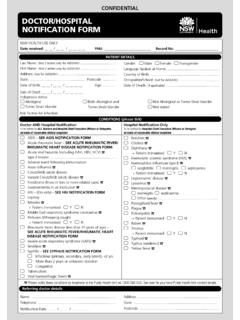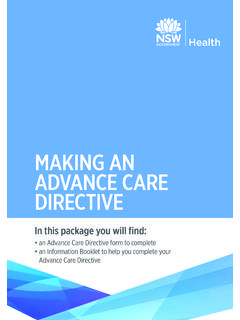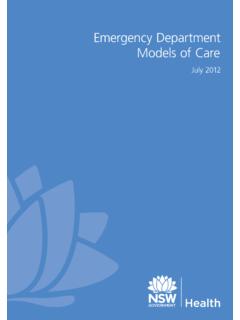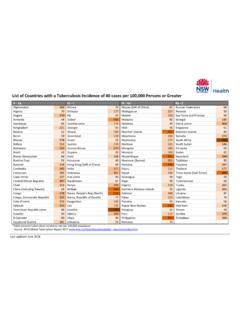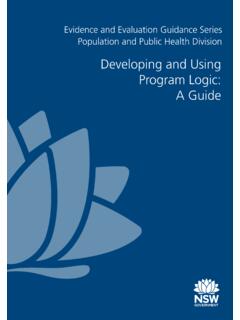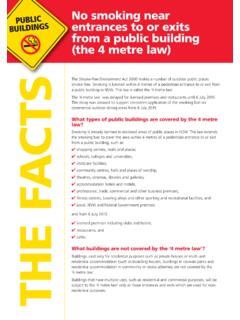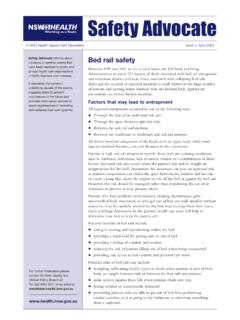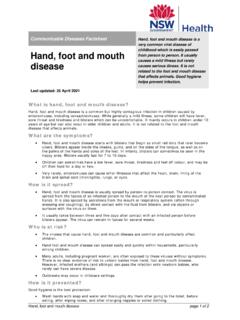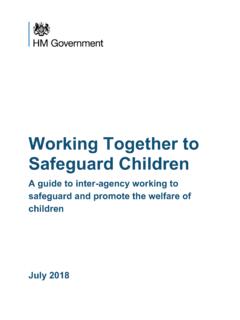Transcription of GASTRO PACK FOR CHILDCARE CENTRES - NSW Health
1 Gastroenteritis Information Pack for CHILDCARE CENTRES Nov 2018 1 GASTRO PACK FOR CHILDCARE CENTRES All CHILDCARE workers and centre directors should refer to this GASTRO Pack for CHILDCARE CENTRES document when there is a gastroenteritis ( GASTRO ) outbreak in their facility. This document provides practical step-by-step guidance on how to manage a GASTRO outbreak, and complements advice in the Staying Healthy guidelines (5th edition, updated June 2013). A GASTRO outbreak occurs when 2 or more children or staff have sudden onset of vomiting or diarrhoea in a 2 day period*.
2 *There may be some instances where illness is more spread out between cases. If there is any uncertainty, please contact your public Health unit. What should I do? 1. Follow the steps listed in this GASTRO Pack for CHILDCARE CENTRES to control the outbreak. Section 1 GASTRO outbreak checklist for CHILDCARE centre Page 2 Section 2 Infection control measures Pages 3-6 Section 3 Signage for CHILDCARE centre Page 7-12 Section 4 Register of sick children and staff Pages 13-15 2. Contact your local Public Health Unit for advice on managing the outbreak. Tel: 1300 066 055 Gastroenteritis Information Pack for CHILDCARE CENTRES Nov 2018 2 SECTION 1.
3 CHECKLIST FOR CHILDCARE CENTRE Step Action Page 1 Inform all staff in the CHILDCARE centre there is a GASTRO outbreak Ensure all staff are familiar with infection control guidelines (pages 3-6) 2 Ensure sufficient cleaning agents and personal protective equipment Liquid handwash, paper towels, alcohol-based hand rubs/gel, neutral detergent ( dishwashing liquid), sodium hypochlorite (bleach) solution, disposable gloves If available, face masks, goggles and long-sleeved impervious gowns for additional protection 3 Implement infection control measures 3-6 4 Display GASTRO outbreak signage in centre 7-12 5 Contact your public Health unit - Tel: 1300 066 055 6 Inform parents Email the GASTRO outbreak letter (provided by your public Health unit) to parents. 7 Complete illness register of sick children and staff Email the register to the public Health unit within 24 hours of contacting them 13-15 8 Inform the public Health unit if 3 days have passed since a child/staff had vomiting/diarrhoea.
4 Email the final register to the public Health unit 9 Remove the GASTRO outbreak signage once the outbreak is declared over by the public Health unit Gastroenteritis Information Pack for CHILDCARE CENTRES Nov 2018 3 SECTION 2: INFECTION CONTROL An outbreak of gastroenteritis can be difficult to control as it is very infectious. Use this infection control checklist when managing a GASTRO outbreak to prevent further spread. Step Action Detail 1 Isolate sick children and staff Remove children/staff with vomiting or diarrhoea from the rest of the group as soon as symptoms appear.
5 This may involve dedicating a room to the sick children before they can be sent home. Call parents and request they pick up their children. 2 Immediately clean up any vomit/faeces and disinfect contaminated surfaces/objects Refer to the Staying Healthy guidelines for further information Essential information Cleaning up immediately after someone vomits or has diarrhoea protects others from getting sick. Surfaces must first be cleaned free of vomit or faeces with a neutral detergent ( dishwashing liquid) and hot water before disinfecting with a sodium hypochlorite (bleach) solution. Bleach should only be used on hard, non-porous surfaces. It is important to thoroughly clean the entire area so you don t miss any drops of vomit or faeces that you can t see. A. Isolate contaminated area and remove vomit/faeces 1. Remove children and staff from the area where vomiting or diarrhoea has occurred.
6 2. Wear disposable plastic gloves. (If available, face mask, goggles and impervious gown offer additional protection.) B. Clean the child (if required) 3. Clean up the child with disposable paper towels. 4. Put the child s soiled clothing in a leak-proof plastic bag for parent to take home and wash. 5. Discard used gloves in a leak-proof plastic bag, then wash your hands thoroughly with soap and warm water. 6. Wash the child s hands. Gastroenteritis Information Pack for CHILDCARE CENTRES Nov 2018 4 C. Clean contaminated surfaces/objects 7. Put on clean disposable plastic gloves.
7 8. Remove as much of the vomit/faeces with disposable paper towels as you can. 9. Seal the used paper towels in a leak-proof plastic bag, then dispose in the bin. 10. Use disposable paper towels to clean all contaminated surfaces and objects with a neutral detergent ( dishwashing liquid) and hot water. 11. Discard used gloves in a leak-proof plastic bag, then dispose in the bin. 12. Wash your hands thoroughly using soap and warm water, then pat dry with a disposable paper towel. D. Disinfect hard surfaces with bleach 13. Put on clean disposable plastic gloves. 14. Freshly prepare the bleach (sodium hypochlorite ) solution following the manufacturer s instructions. White King bleach (sodium hypochlorite 42g/L) dilute 1 part bleach (25mL) in 40 parts water (1L) to make solution 15. Use disposable paper towels to thoroughly wipe the area with the bleach solution.
8 16. Discard the used paper towels in a leak-proof plastic bag, then dispose in the bin. 17. Leave the bleach on the surface for at least 10 minutes (to kill the virus), then rinse with cold water. Allow surface to dry thoroughly. 18. Discard gloves, mask and gown (and face shield if using) in a leak-proof plastic bag, then dispose in the bin. 19. Wash reusable goggles (if using) with detergent and water, followed by bleach solution (if able), and then allow to dry thoroughly. 20. Wash your hands thoroughly using soap and warm water, then pat dry with a disposable paper towel. 3 Perform hand hygiene regularly 1. Ensure hand washing facilities, liquid hand wash, paper towels and alcohol hand rub are available for staff, children and visitors. (Do not use hand towels during outbreaks.) Gastroenteritis Information Pack for CHILDCARE CENTRES Nov 2018 5 Good hand hygiene is the most effective way of preventing the spread of infection.
9 2. Alert staff, children and visitors to the outbreak and the need to perform regular hand hygiene. Post hand hygiene signs in toilet and care areas. 3. Hand hygiene should be performed: On arrival to the centre and before leaving the centre After going to the toilet Before preparing/handling food, including a baby s bottle Before and after eating After contact with a person with GASTRO After cleaning up vomit, faeces or blood After handling dirty items ( garbage, soiled toys) Before and after providing care ( changing a nappy , wiping a nose, assisting a child in the toilet, giving medication) After wiping/blowing a nose, sneezing or coughing Before and after touching any cut, wound or rash (yours or the child) After playing outside After removing gloves 4. Wash your hand with liquid soap and running water if Hands are visibly dirty After using the toilet There are body fluids ( blood, urine, faeces) on your hands.
10 You can use alcohol hand rub to clean your hands for other situations. Staff should minimise wearing jewellery below the elbows and not have artificial nails. 5. Hands should be washed according to the following steps: (i) Use running water and liquid soap Gastroenteritis Information Pack for CHILDCARE CENTRES Nov 2018 6 (ii) Vigorously wash hands all over for 20 seconds Pay special attention to palms, back of hands, in between fingers, under finger nails and around wrists (iii) Rinse hands thoroughly for 10 seconds (iv) Dry hands well with a paper towel (v) Turn off tap with a paper towel 6.
